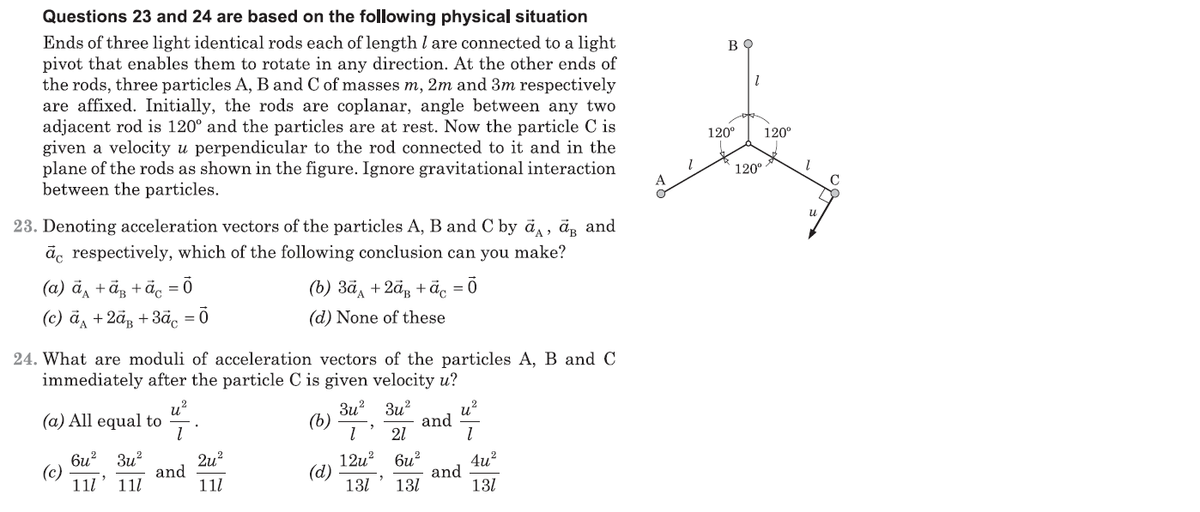Ends of three light identical rods each of length l are connected to a light pivot that enables them to rotate in any direction. At the other ends of the rods, three particles A, B and C of masses m, 2m and 3m respectively are affixed. Initially the rods are coplanar, angle between any two is 120 and the particles are at rest. Now the particle C is given a velocity u perpendicular to the rod connected to it and in the plane of the rods as shown in the figure. Ignore gravitational interaction between
Ends of three light identical rods each of length l are connected to a light pivot that enables them to rotate in any direction. At the other ends of the rods, three particles A, B and C of masses m, 2m and 3m respectively are affixed. Initially the rods are coplanar, angle between any two is 120 and the particles are at rest. Now the particle C is given a velocity u perpendicular to the rod connected to it and in the plane of the rods as shown in the figure. Ignore gravitational interaction between
Elements Of Electromagnetics
7th Edition
ISBN:9780190698614
Author:Sadiku, Matthew N. O.
Publisher:Sadiku, Matthew N. O.
ChapterMA: Math Assessment
Section: Chapter Questions
Problem 1.1MA
Related questions
Question
Ends of three light identical rods each of length l are connected to a light pivot that enables them to rotate in any direction. At the other ends of the rods, three particles A, B and C of masses m, 2m and 3m respectively are affixed. Initially the rods are coplanar, angle between any two is 120 and the particles are at rest. Now the particle C is given a velocity u perpendicular to the rod connected to it and in the plane of the rods as shown in the figure. Ignore gravitational interaction between the particles. What are the moduli of acceleration of the particles A, B and C immediately after the particle C is given velocity u?

Transcribed Image Text:Questions 23 and 24 are based on the following physical situation
Ends of three light identical rods each of length l are connected to a light
pivot that enables them to rotate in any direction. At the other ends of
the rods, three particles A, B and C of masses m, 2m and 3m respectively
are affixed. Initially, the rods are coplanar, angle between any two
adjacent rod is 120° and the particles are at rest. Now the particle C is
given a velocity u perpendicular to the rod connected to it and in the
plane of the rods as shown in the figure. Ignore gravitational interaction
between the particles.
120°
120°
120°
23. Denoting acceleration vectors of the particles A, B and C by ā, ä, and
āc respectively, which of the following conclusion can you make?
(а) ӑд + ӑз + ӑ, -ӧ
(c) ā, +2ãg +3ãc = Ō
(b) 3ã, +2ã, + äc = 0
(d) None of these
24. What are moduli of acceleration vectors of the particles A, B and C
immediately after the particle C is given velocity u?
,2
(a) All equal to
3u? 3u?
and
21
u?
(b)
би? Зи?
2u?
and
11l
12u? 6и?
and
131
4u?
(c)
11l' 111
(d)
131
131
Expert Solution
This question has been solved!
Explore an expertly crafted, step-by-step solution for a thorough understanding of key concepts.
This is a popular solution!
Trending now
This is a popular solution!
Step by step
Solved in 2 steps

Knowledge Booster
Learn more about
Need a deep-dive on the concept behind this application? Look no further. Learn more about this topic, mechanical-engineering and related others by exploring similar questions and additional content below.Recommended textbooks for you

Elements Of Electromagnetics
Mechanical Engineering
ISBN:
9780190698614
Author:
Sadiku, Matthew N. O.
Publisher:
Oxford University Press

Mechanics of Materials (10th Edition)
Mechanical Engineering
ISBN:
9780134319650
Author:
Russell C. Hibbeler
Publisher:
PEARSON

Thermodynamics: An Engineering Approach
Mechanical Engineering
ISBN:
9781259822674
Author:
Yunus A. Cengel Dr., Michael A. Boles
Publisher:
McGraw-Hill Education

Elements Of Electromagnetics
Mechanical Engineering
ISBN:
9780190698614
Author:
Sadiku, Matthew N. O.
Publisher:
Oxford University Press

Mechanics of Materials (10th Edition)
Mechanical Engineering
ISBN:
9780134319650
Author:
Russell C. Hibbeler
Publisher:
PEARSON

Thermodynamics: An Engineering Approach
Mechanical Engineering
ISBN:
9781259822674
Author:
Yunus A. Cengel Dr., Michael A. Boles
Publisher:
McGraw-Hill Education

Control Systems Engineering
Mechanical Engineering
ISBN:
9781118170519
Author:
Norman S. Nise
Publisher:
WILEY

Mechanics of Materials (MindTap Course List)
Mechanical Engineering
ISBN:
9781337093347
Author:
Barry J. Goodno, James M. Gere
Publisher:
Cengage Learning

Engineering Mechanics: Statics
Mechanical Engineering
ISBN:
9781118807330
Author:
James L. Meriam, L. G. Kraige, J. N. Bolton
Publisher:
WILEY